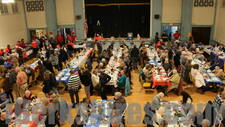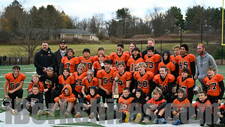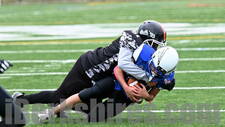Candles A Burning MatterBy Susan Bush
12:00AM / Wednesday, October 05, 2005
 | | Pretty, but potentially deadly |
Adams – The Adams Volunteer Fire department has scheduled an Oct. 12 open house as part of National Fire Prevention Week.
This year’s fire prevention week theme is “Prevent Candle Fires;†the open house is scheduled to begin at 6 p.m. and end at 8:30 pm. at the 3 Columbia St. fire house.
Emergency services dispatcher and event organizer Michael Pisconeri encouraged families to attend the open house. Becoming familiar with the department and learning about the hazards posed by candles will benefit the community members, he said during an Oct. 4 interview.
“We’d like people to come down and see what the fire department and fire safety means to the community,†he said. “The theme this year is how to prevent candle fires. Candles are in many homes and can pose a fire danger. Our motto is ‘if you go out, blow out.’â€
Candle Fires on Rise
Candles have become very popular home accessories and people are burning candles in increasing numbers. That has led to an increase in candle-caused fires; in 1990, 5,500 candle fires were reported to the National Fire Protective Association. During 2001 and 2002, about 18,000 such fires were reported to the agency, a three-fold increase occurring within a 12-year period.
Candle fires led to 130 deaths, 1,350 injuries, and about $333 million in direct property damage, according to information provided by the fire protective association.
Bedrooms are a prime location for candle fires; about 40 percent of house fires started by candles occurred in a bedroom. Candle fires in bedrooms also accounted for about 30 percent of candle fire related deaths.
Candle flames have ignited mattresses and bedding, curtains, upholstered furniture and cabinets. While five percent of the reported candle fires did ignite furniture, those fires caused 17 percent of the reported deaths, according to NFPA information. Monthly, about eight percent of all fires are caused by candles except for December, when the rate jumps to 14 percent.
Winter poses additional risks; a NFPA study of news information and fire reports from 1997 and 1998 revealed that candles being used in place of electricity were the cause of one out of every three evaluated candle fires that claimed human life. About one in four of those fires occurred in homes that had had electrical service terminated. Candle-related fatal fires also occurred during temporary power outages.
Put The Flame Out
Candle safety tips include extinguishing candle flames even when leaving a room for a few minutes, and checking to be certain all candle flames are snuffed out before going to bed. Candles should be kept well away from any item that can ignite, such as curtains, books, and pillows. Candleholders should be large enough to accommodate candle size and should have plenty of space to catch dripping, hot wax. Flashlights should be used during power outages.
Two Catastrophic Fires On Oct. 8 1871
National Fire Prevention Week has its roots with the 1871 Chicago and Peshtigo, Wisconsin fires. In both cases, the flames erupted on Oct. 8. In Chicago, the fire burned well into Oct. 9, claimed over 250 lives, left over 100,000 people homeless, burned over 2,000 acres and razed over 17,400 buildings.
The Peshtigo fire is noted by fire historians as the most damaging forest fire in American history and caused catastrophe throughout northeastern Wisconsin. The fire consumed 16 towns, killed about 1,152 people, and burned 1.2 million acres. Flames leveled the Peshtigo community in one hour, according to NFPA information.
The horrific fires altered perceptions about public awareness and fire safety. In 1920, President Woodrow Wilson declared the first National Fire prevention Day, and beginning during 1922, National Fire Prevention Week has been designated as the Sunday-Saturday time frame during which Oct. 9 falls.
Fire prevention week is documented as the longest consecutive recorded public health and safety campaign in the country, according to the National Archives and Record Administration’s Library Information Center.
Every U.S. president signed a proclamation designating fire prevention week since 1925.
Additional information about the Adams Volunteer Fire Department open house or fire prevention week may be acquired by calling 413-743-1929.
Information about fire prevention and National Fire Prevention Week is available at a www.nfpa.org Internet web site.
Susan Bush may be reached via e-mail at suebush@iberkshires.com or at 802-823-9367.
|



















